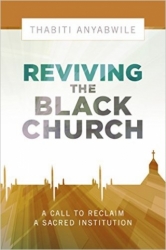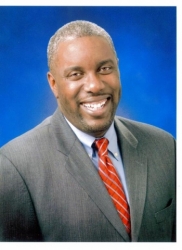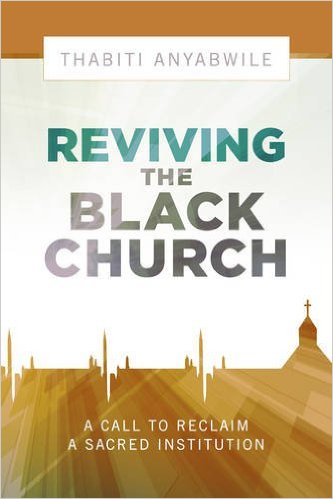Books At a Glance (Fred Zaspel): 
Hi, this is Fred Zaspel at Books At a Glance. We’re talking today with Thabiti Anyabwile. Reviving the Black Church: New Life for a Sacred Institution is his new book. Thabiti is a friend of ours, he is a member of our board of reference here at Books At a Glance, we have featured some of his books before but I think this is the first time we’ve had him talk to us in our interviews. Thabiti, thanks for coming, it’s good to have you with us.
Thabiti Anyabwile:
Hey Fred it’s good to be with you guys and thanks again for what you do with Books At a Glance. I’m glad for the way the Lord has been using it to bless many of his people.
Zaspel:
Thanks. All right first of all tell us about the work you’re involved in before we get to your new book. Let’s talk about what you are doing. You are back in DC now and you are planting a church, right?
Anyabwile:
That’s correct. So we spent the last eight years in the Cayman Islands pastoring the wonderful Saints at first Baptist Church at Grand Cayman and the Lord began about two years ago to turn our hearts back to the states and to turn our hearts to a particular community in Southeast DC called Anacostia. Which historically is where Frederick Douglass made his home and it’s an area of the city which, at least since the 60s, has been in significant need. Part of that need of course, is gospel need and so we’ve launched Anacostia River church by God’s grace on Easter Sunday of this year and seven months in we are continuing to experience the richness of his grace.
Zaspel:
Great, you are encouraged with the work?
Anyabwile:
Very encouraged. Two other guys are serving with me as fantastic elders. The Lord has made us a warm family so far and sent a lot of people with real evangelistic zeal so we have all the good things you need for a plant in this context.
Zaspel:
Is the church predominately African-American or is it ethnically mixed?
Anyabwile:
It is mixed, but it is predominantly African-American. If I had to guess it would be 60 to 65% African-American and 35% or so other. The community itself is 94% African-American so we are a somewhat diverse congregation in the community.
Zaspel:
Okay let’s talk about your new book, Reviving the Black Church: New Life for Sacred Institution. Your concern is to revive the black church. Now we might wish for revival for any church of any stripe, ethnic or otherwise, so does your title reflect some particular concerns with regard to the African-American church or is it just that the African-American church is your targeted audience? What’s your concern? Give us some background here.
Anyabwile:
I think it’s a little bit of both. Several years ago Princeton professor Eddie Glaude sort of called the question. Well, he didn’t call the question, he made a statement. He said the black church is dead, and as you can imagine that created a bit of an uproar in various quarters. From Glaude’s perspective, the church is dead because he doesn’t think it’s as engaged in politics and prophetic political causes the way he thinks it ought to be.
My reply to that of course is: if she’s dead, she’s not dead for that reason because that’s not what gives the church life. I’m not convinced she’s dead, but you know in all ages, in all quarters of the vineyard there are churches that are healthy, there are churches that are ill, there are churches who are dying and what they all need is a return to the word of God. We live by every word that comes from the mouth of God. And so this book was an effort to say, here’s what makes for life and here’s what a church built upon the word of God, here’s how that might be expressed in various parts of its life.
Zaspel:
Who is your target audience? Is it pastors, church leaders, everybody in the church?
Anyabwile:
Yeah, you know, it’s written to do two things. It’s written to, in some ways, give a blueprint for church leaders, pastors, elders, deacons, trustees in the African church or any church I think would find it helpful. But it’s also written with the hope of being able to give the person in the pew a good sense of what a healthy church looks like, what a living church looks like.
You know, Fred, I’ve never met a Christian who’s been involved in the church who didn’t want their church to be healthy. And if you asked them the question what does it look like for your church to be vibrant, well then you get sort of misty answers, vague answers, subjective senses of what it might look like. And so then for the reading Christian in the pew who wants their church to be alive and vigorous I hope this is also an indication to them what to look for, what to pray for, how to contribute along with their leaders to the life of their church.
Zaspel:
Just glancing through the table of contents, even the agenda that you’re offering to revive the black church looks to me like an agenda you would want to hold out for any church, isn’t that right? At least broadly speaking?
Anyabwile:
I think that’s right. The way I put it, Fred, is that there’s nothing the African-American church needs that all churches don’t need. There may be some particular ways that things are expressed or some particular historical cultural things to attend to but at the bottom, we are all God’s people. And all God’s people need the same thing. We need the nourishing, replenishing, life-giving power of his word.
Zaspel:
Yes, that’s got to be right. Alright, sketch out for us then the agenda you have in the book.
Anyabwile:
In broad strokes, what I’m suggesting is that revival would come as we apply the word of God to three broad areas. The first area is the ministry of the word itself in preaching, and singing, and things of that sort. That the word of God needs to be line upon line, precept upon precept fed to God’s people. The second area is as we revive the church through godly leadership, and that’s going to involve removing the ungodly and the unqualified. A very difficult but very necessary thing. It’s going to involve calling the qualified. And it’s going to involve opening the word to think through how we train men for the ministry. So we have three or four chapters thinking about leadership there. And in the last section is reviving by mission and membership. And so there we are concerned about the ways in which we have to create borders between the church and the world, and then about how the church goes into the world to reclaim souls for Christ.
Zaspel:
I was curious in the first section you have a defensive exposition which is great but then you have a second chapter on that, a defensive exposition in non-white context. What’s going on behind that?
Anyabwile:
Well here’s the place that I think these issues can take on a particular cultural sort of bent. African-American churches are known for their oratory, they are known for their preaching and emotive, powerful, colorful preaching. And it’s good preaching as long as it’s tethered to the word, and so part of what I want to argue here is that the best way to give people a well-rounded Biblical diet is to preach sequentially through books of the Bible and to have the main point of the passage drive the preaching. What we call expository preaching.
But in the context there are all kinds of objections that are raised about it in terms of whether or not that is “white” preaching, or whether or not that’s culturally relevant preaching, will it work in a church that has such a rich preaching tradition that’s not always associated with exposition? And so I try to take on some of those objectives head-on and to show that actually exposition is a kind of transcultural approach to preaching, that clarity is a kind of common currency across cultures and ethnicities and so if we would communicate not just in our context and in our subcultural space, but beyond it as well, then our best chance of doing that is committing ourselves as preachers to being expositors.
Zaspel:
Amen. Another distinctive perhaps is your particular focus in chapter 12 on reclaiming black men and the black family. Again, like the rest of your book, this is very applicable to any church, but it’s not often we find that in a book on reviving the church. So talk to us about that. How do we go about reclaiming men and families?
Anyabwile:
Where the African-American church is concerned and the African-American community is concerned, there’s just been a long history of challenge, onslaught, maligning of African-American men and so part of what we have to do as a church is changing our language about men. I mean, you know, Father’s Day is that day in many churches where men show up to church once a year and they get hammered and beat up for being poor dads and things of that sort, so there’s almost an adversarial relationship with men in some churches.
And so we’ve got to change that dynamic. We’ve got to put two things in place. We’ve got to embrace the Bible’s view of gender roles and family structure, and we’ve got to apply that in the church as well. So that’s one thing and we got to be accountable. Men who are in leadership in the church have to be held accountable. Lots of African-American men will tell you they don’t go to church because, and you hear this in all kinds of communities, they suspect that the preacher only wants the money, and they suspect that the preacher is morally corrupt in various ways, and those are things that they get beat up for but the preacher gets away with and they see a kind of hypocrisy in that.
And you know what, that’s oversold, that’s overdone. I think that’s a critique that has spread far too wide but it is true in some instances and so there’s an apologetic that we have to develop with African-American men in order to reach them. And this is vitally important because as goes the family so goes the whole community and so goes the church in many respects. So we’ve just got to fight this war, and it is war, for the well-being of African-American men.
Zaspel:
Amen. All right one more question. Your title reflects the fact churches in the US, both black and white, tend to be segregated. Now sometimes that’s just the reflection of the community itself. That’s fair enough. But more broadly speaking they tend to be segregated. So if you could make one plea to both sides what would it be?
Anyabwile:
Oh, work really, really hard to make sure that our primary and foundational identity is that of Christians, that we are a new spiritual ethnicity made up of people from every tribe and language. And that’s where we’re headed in glory, and we have not had, Fred, enough theological reflection, and we have not had enough practical resources dedicated to helping people actually work that out and apply that. How it is that we live and think as Christians first and then most appropriately appreciate who God has made us to be ethnically. We’ve just got a lot of work to do on that, but praise God he has accomplished it in Christ on the cross and he has given us his Spirit. We have every spiritual blessings in heavenly places. We can grow in this way.
Zaspel:
Brother, I think that’s the best answer to the question that I’ve heard. I think it’s the best that can be given. Amen. Thanks.
Alright, it’s been good to have you with us, thanks for coming with us, Thabiti. I trust that your book will have some good influence. We pray God’s blessing upon your work there in DC as well. We appreciate your ministry, I love your preaching and we pray for you.
Anyabwile:
We appreciate all of that, brother. Blessings to you as well, and the Lord continue to keep his hand upon you and your ministry and your family.

